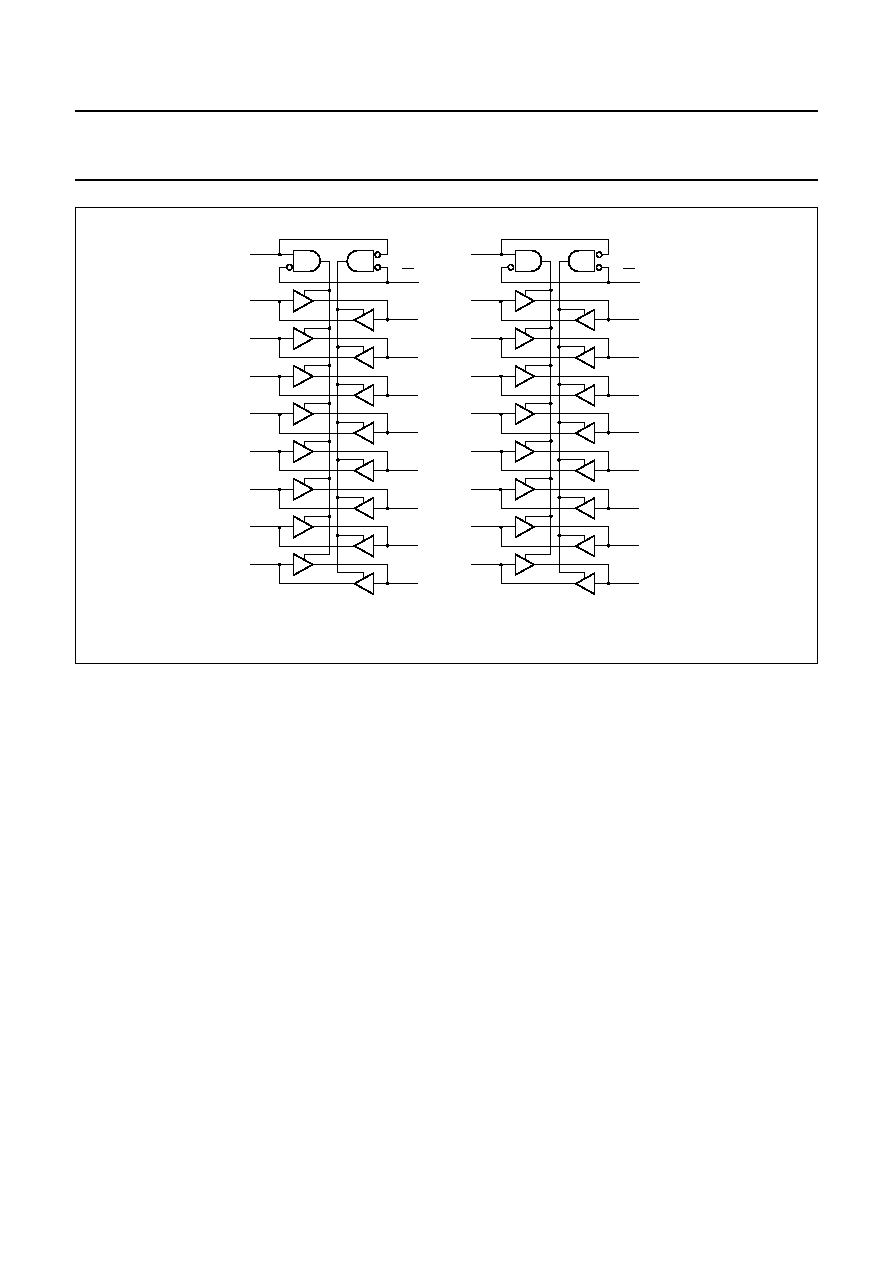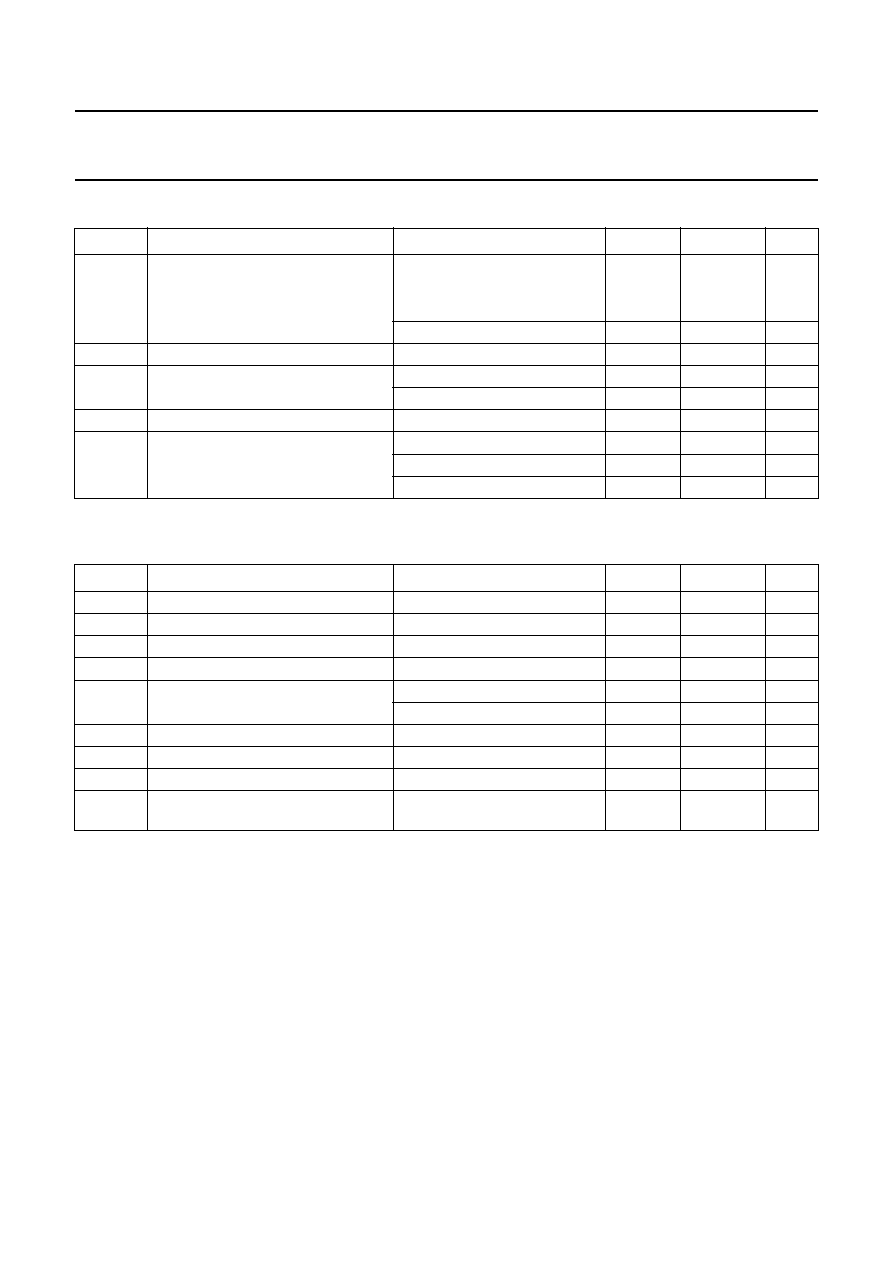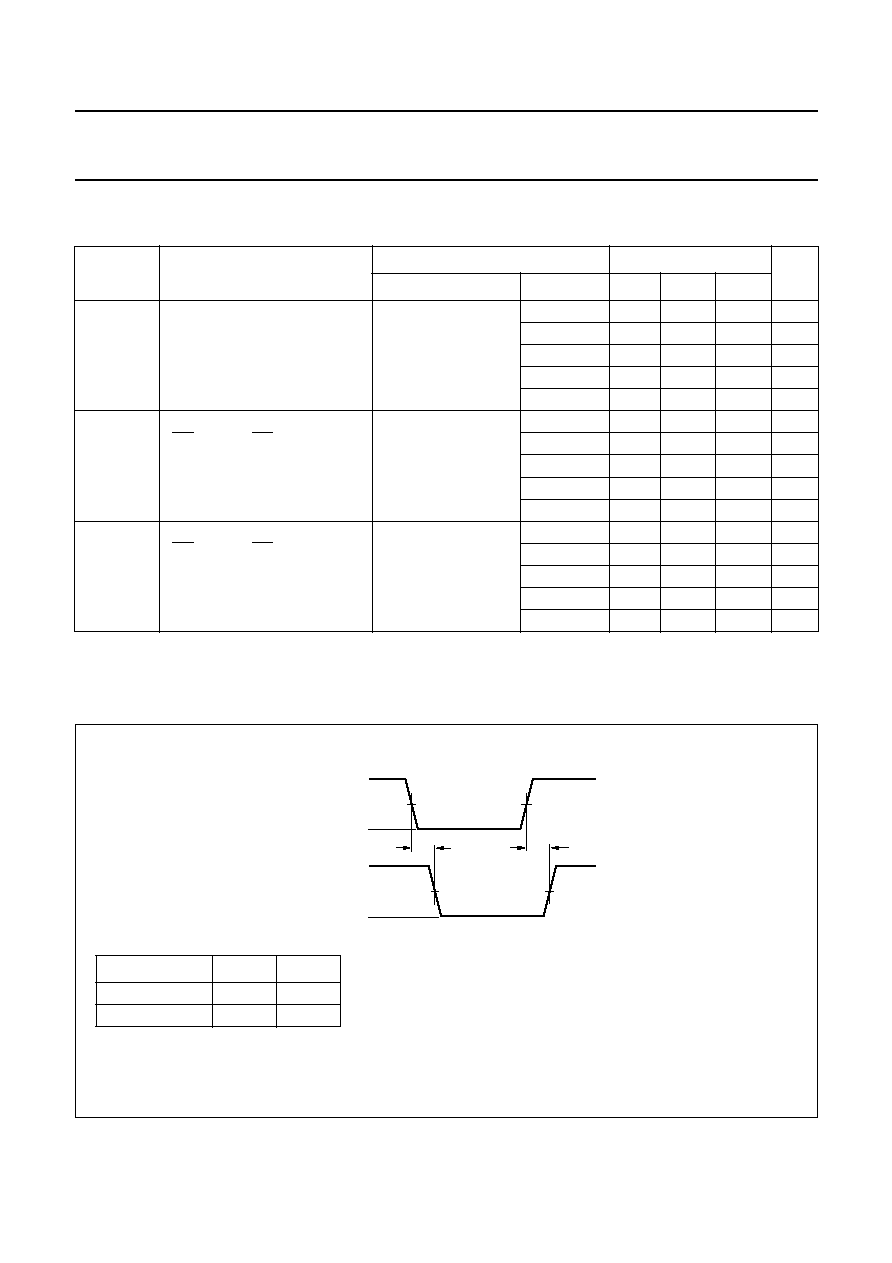
DATA SHEET
Product specification
Supersedes data of 1998 Dec 11
File under Integrated Circuits, IC24
1999 Nov 15
INTEGRATED CIRCUITS
74AVC16245
16-bit transceiver with direction pin;
3-state (3.6 V tolerant)

1999 Nov 15
2
Philips Semiconductors
Product specification
16-bit transceiver with direction pin; 3-state
(3.6 V tolerant)
74AVC16245
FEATURES
∑
Wide supply voltage range from 1.2 to 3.6 V
∑
Complies with JEDEC standard no. 8-1A/5/7
∑
CMOS low power consumption
∑
Input/output tolerant up to 3.6 V
∑
Dynamic Controlled Output (DCO) circuit dynamically
changes output impedance, resulting in noise reduction
without speed degradation
∑
Low inductance multiple power and ground pins for
minimum noise and ground bounce
∑
Power off disables outputs, permitting live insertion.
DESCRIPTION
The 74AVC16245 is a 16-bit transceiver featuring
non-inverting 3-state bus compatible outputs in both send
and receive directions.
The 74AVC16245 features two output enable inputs (nOE)
for easy cascading and two send/receive inputs (nDIR) for
direction control. Input nOE controls the outputs so that the
buses are effectively isolated. This device can be used as
two 8-bit transceivers or one 16-bit transceiver.
This product is designed to have an extremely fast
propagation delay and a minimum amount of power
consumption.
To ensure the high-impedance output state during
power-up or power-down, input nOE should be tied to V
CC
through a pull-up resistor (live insertion).
A DCO circuitry is implemented to support termination line
drive during transient (see Figs 1 and 2).
handbook, halfpage
0
1
2
4
0
-
200
-
300
-
100
MNA506
3
VOH (V)
IOH
(mA)
1.8 V
2.5 V
3.3 V
Fig.1 Output current as function of output voltage.
handbook, halfpage
0
1
2
4
300
100
0
200
MNA507
3
VOL (V)
IOL
(mA)
1.8 V
2.5 V
3.3 V
Fig.2 Output current as function of output voltage.

1999 Nov 15
3
Philips Semiconductors
Product specification
16-bit transceiver with direction pin; 3-state
(3.6 V tolerant)
74AVC16245
QUICK REFERENCE DATA
GND = 0 V; T
amb
= 25
∞
C; t
r
= t
f
2.0 ns; C
L
= 30 pF.
Notes
1. C
PD
is used to determine the dynamic power dissipation (P
D
in
µ
W).
P
D
= C
PD
◊
V
CC
2
◊
f
i
+
(C
L
◊
V
CC
2
◊
f
o
) where:
f
i
= input frequency in MHz;
f
o
= output frequency in MHz;
C
L
= output load capacitance in pF;
V
CC
= supply voltage in Volts;
(C
L
◊
V
CC
2
◊
f
o
) = sum of outputs.
2. The condition is V
I
= GND to V
CC
.
FUNCTION TABLE
See note 1.
Note
1. H = HIGH voltage level;
L = LOW voltage level;
X = don't care;
Z = high-impedance OFF-state.
SYMBOL
PARAMETER
CONDITIONS
TYP.
UNIT
t
PHL
/t
PLH
propagation delay nA
n
to nB
n
;
nB
n
to nA
n
V
CC
= 1.2 V
2.8
ns
V
CC
= 1.5 V
1.8
ns
V
CC
= 1.8 V
1.8
ns
V
CC
= 2.5 V
1.3
ns
V
CC
= 3.3 V
1.1
ns
C
I
input capacitance
5.0
pF
C
PD
power dissipation capacitance per buffer notes 1 and 2
outputs enabled
42
pF
outputs disabled
2
pF
INPUTS
INPUTS/OUTPUTS
nOE
nDIR
nA
n
nB
n
L
L
A = B
inputs
L
H
inputs
B = A
H
X
Z
Z

1999 Nov 15
4
Philips Semiconductors
Product specification
16-bit transceiver with direction pin; 3-state
(3.6 V tolerant)
74AVC16245
ORDERING INFORMATION
PINNING
TYPE NUMBER
PACKAGE
TEMPERATURE RANGE
PINS
PACKAGE
MATERIAL
CODE
74AVC16245DGG
-
40 to +85
∞
C
48
TSSOP
plastic
SOT362-1
PIN
SYMBOL
DESCRIPTION
1
1DIR
direction control
2, 3, 5, 6, 8, 9, 11 and 12
1B
0
to 1B
7
data inputs/outputs
4, 10, 15, 21, 28, 34, 39 and 45
GND
ground (0 V)
7, 18, 31 and 42
V
CC
DC supply voltage
13, 14, 16, 17, 19, 20, 22 and 23
2B
0
to 2B
7
data inputs/outputs
24
2DIR
direction control
25
2OE
output enable input (active LOW)
26, 27, 29, 30, 32, 33, 35 and 36
2A
7
to 2A
0
data inputs/outputs
37, 38, 40, 41, 43, 44, 46 and 47
1A
7
to 1A
0
data inputs/outputs
48
1OE
output enable input (active LOW)

1999 Nov 15
5
Philips Semiconductors
Product specification
16-bit transceiver with direction pin; 3-state
(3.6 V tolerant)
74AVC16245
handbook, halfpage
16245
MNA508
1
2
3
4
5
6
7
8
9
10
11
12
13
14
15
16
17
18
19
20
21
22
23
24
26
25
48
47
46
45
44
43
42
41
40
39
38
37
36
35
34
33
32
31
30
29
28
27
1DIR
1B0
1B1
GND
1B2
1B3
VCC
1B4
1B5
GND
1B6
1B7
2B0
2B1
GND
2B2
2B3
VCC
2B4
2B5
GND
2B6
2B7
2DIR
1OE
1A0
1A1
GND
1A2
1A3
VCC
1A4
1A5
GND
1A6
1A7
2A0
2A1
GND
2A2
2A3
VCC
2A4
2A5
GND
2A6
2A7
2OE
Fig.3 Pin configuration.
G3
G6
3EN1[BA]
6EN1[BA]
3EN2[AB]
6EN2[AB]
2
13
47
36
46
35
3
14
44
33
5
16
43
32
6
17
41
30
8
19
40
29
9
20
38
27
11
22
37
26
12
23
1A0
2A1
2A0
2A2
2A3
2A4
2A5
2A6
2A7
2B1
2B2
2B3
2B4
2B5
2B6
2B7
1OE
1DIR
MNA003
1A1
1A2
1A3
1A4
1A5
1A6
1A7
1B0
2B0
1B1
1B2
1B3
1B4
1B5
1B6
1B7
5
4
2
1
25
24
48
1
2OE
2DIR
Fig.4 IEEE/IEC logic symbol.

1999 Nov 15
6
Philips Semiconductors
Product specification
16-bit transceiver with direction pin; 3-state
(3.6 V tolerant)
74AVC16245
Fig.5 Logic symbol.
handbook, full pagewidth
47
1
1DIR
2
48
1B0
1B1
1B2
1B3
1B4
1B5
1B6
1B7
46
3
44
5
43
6
41
8
40
9
38
11
37
1A0
1A1
1A2
1A3
1A4
1A5
1A6
1A7
12
1OE
36
24
2DIR
13
25
2B0
2B1
2B2
2B3
2B4
2B5
2B6
2B7
35
14
33
16
32
17
30
19
29
20
27
22
26
2A0
2A1
2A2
2A3
2A4
2A5
2A6
2A7
23
2OE
MNA509

1999 Nov 15
7
Philips Semiconductors
Product specification
16-bit transceiver with direction pin; 3-state
(3.6 V tolerant)
74AVC16245
RECOMMENDED OPERATING CONDITIONS
LIMITING VALUES
In accordance with the Absolute Maximum Rating System (IEC 134); voltages are referenced to GND (ground = 0 V).
Notes
1. The input and output voltage ratings may be exceeded if the input and output current ratings are observed.
2. Above 60
∞
C the value of P
D
derates linearly with 5.5 mW/K.
SYMBOL
PARAMETER
CONDITIONS
MIN.
MAX.
UNIT
V
CC
DC supply voltage
according JEDEC low-voltage
standards
1.65
1.95
V
2.3
2.7
V
3.0
3.6
V
low-voltage applications
1.2
3.6
V
V
I
DC input voltage
0
3.6
V
V
O
DC output voltage
3-state
0
3.6
V
HIGH or LOW state
0
V
CC
V
T
amb
operating ambient temperature
in free air
-
40
+
85
∞
C
t
r
, t
f
input rise and fall times
V
CC
= 1.65 to 2.3 V
0
30
ns/V
V
CC
= 2.3 to 3.0 V
0
20
ns/V
V
CC
= 3.0 to 3.6 V
0
10
ns/V
SYMBOL
PARAMETER
CONDITIONS
MIN.
MAX.
UNIT
V
CC
DC supply voltage
-
0.5
+4.6
V
I
IK
DC input diode current
V
I
< 0 V
-
-
50
mA
V
I
DC input voltage
for inputs; note 1
-
0.5
+4.6
V
I
OK
DC output diode current
V
O
> V
CC
or V
O
< 0 V
-
±
50
mA
V
O
DC output voltage
HIGH or LOW state; note 1
-
0.5
V
CC
+ 0.5
V
3-state; note 1
-
0.5
+4.6
V
I
O
DC output source or sink current
V
O
= 0 V to V
CC
-
±
50
mA
I
CC
,I
GND
DC V
CC
or GND current
-
±
100
mA
T
stg
storage temperature
-
65
+150
∞
C
P
tot
power dissipation per package
temperature range from
-
40 to +85
∞
C; note 2
-
500
mW

1999 Nov 15
8
Philips Semiconductors
Product specification
16-bit transceiver with direction pin; 3-state
(3.6 V tolerant)
74AVC16245
DC CHARACTERISTICS
Over recommended operating conditions; voltages are referenced to GND (ground = 0 V).
Note
1. All typical values are measured at T
amb
= 25
∞
C.
SYMBOL
PARAMETER
TEST CONDITIONS
T
amb
=
-
40 to +85
∞
C
UNIT
OTHER
V
CC
(V)
MIN.
TYP.
(1)
MAX.
V
IH
HIGH-level input
voltage
1.2
V
CC
-
-
V
1.65 to 1.95
0.65V
CC
0.9
-
V
2.3 to 2.7
1.7
1.2
-
V
3.0 to 3.6
2.0
1.5
-
V
V
IL
LOW-level input
voltage
1.2
-
-
GND
V
1.65 to 1.95
-
0.9
0.35V
CC
V
2.3 to 2.7
-
1.2
0.7
V
3.0 to 3.6
-
1.5
0.8
V
V
OH
HIGH-level output
voltage
V
I
= V
IH
or V
IL
I
O
=
-
100
µ
A
1.65 to 3.6
V
CC
-
0.20
V
CC
-
V
I
O
=
-
4 mA
1.65
V
CC
-
0.45
V
CC
-
0.10
-
V
I
O
=
-
8 mA
2.3
V
CC
-
0.55
V
CC
-
0.28
-
V
I
O
=
-
12 mA
3.0
V
CC
-
0.70
V
CC
-
0.32
-
V
V
OL
LOW-level output
voltage
V
I
= V
IH
or V
IL
I
O
= 100
µ
A
1.65 to 3.6
-
GND
0.20
V
I
O
= 4 mA
1.65
-
0.10
0.45
V
I
O
= 8 mA
2.3
-
0.26
0.55
V
I
O
= 12 mA
3.0
-
0.36
0.70
V
I
I
input leakage
current per pin
V
I
= V
CC
or GND
1.65 to 3.6
-
0.1
2.5
µ
A
I
off
power off leakage
current
V
I
or V
O
= 3.6
0
-
0.1
±
10
µ
A
I
IHZ
/I
ILZ
input current for
common I/O pins
V
I
= V
CC
or GND
1.65 to 3.6
-
0.1
12.5
µ
A
I
OZ
3-state output
OFF-state current
V
I
= V
IH
or V
IL
;
V
O
= V
CC
or GND
1.65 to 2.7
-
0.1
5
µ
A
3.0 to 3.6
-
0.1
10
µ
A
I
CC
quiescent supply
current
V
I
= V
CC
or GND;
I
O
= 0
1.65 to 2.7
-
0.1
20
µ
A
3.0 to 3.6
-
0.2
40
µ
A

1999 Nov 15
9
Philips Semiconductors
Product specification
16-bit transceiver with direction pin; 3-state
(3.6 V tolerant)
74AVC16245
AC CHARACTERISTICS
GND = 0 V; t
r
= t
f
2.0 ns; C
L
= 30 pF.
Note
1. All typical values are measured at T
amb
= 25
∞
C and at V
CC
= 1.2 V, 1.5 V, 1.8 V, 2.5 V or 3.3 V.
SYMBOL
PARAMETER
TEST CONDITIONS
T
amb
=
-
40 to +85
∞
C
UNIT
WAVEFORMS
V
CC
(V)
MIN.
TYP.
(1)
MAX.
t
PHL
/t
PLH
propagation delay
nA
n
to nB
n
; nB
n
to nA
n
see Figs 6 and 8
1.2
-
2.8
-
ns
1.40 to 1.60
-
1.8
-
ns
1.65 to 1.95
0.7
1.8
3.0
ns
2.3 to 2.7
0.6
1.3
1.9
ns
3.0 to 3.6
0.5
1.1
1.7
ns
t
PZH
/t
PZL
3-state output enable time
nOE to nA
n
; nOE to nB
n
see Figs 7 and 8
1.2
-
5.9
-
ns
1.40 to 1.60
-
3.9
-
ns
1.65 to 1.95
1.4
3.3
6.5
ns
2.3 to 2.7
1.0
2.4
4.5
ns
3.0 to 3.6
0.7
2.0
3.7
ns
t
PHZ
/t
PLZ
3-state output disable time
nOE to nA
n
; nOE to nB
n
see Figs 7 and 8
1.2
-
6.9
-
ns
1.40 to 1.60
-
4.8
-
ns
1.65 to 1.95
2.2
3.7
6.0
ns
2.3 to 2.7
1.1
2.0
4.2
ns
3.0 to 3.6
1.2
2.2
3.7
ns
AC WAVEFORMS
handbook, halfpage
MNA511
nAn, nBn
input
nBn, nAn
output
tPHL
tPLH
GND
VI
VM
VM
VOH
VOL
Fig.6 The input (nA
n
, nB
n
) to output (nB
n
, nA
n
) propagation delay.
V
CC
V
M
V
I
2.3 to 2.7 V
0.5V
CC
V
CC
3.0 to 3.6 V
0.5V
CC
V
CC
V
OL
and V
OH
are typical output voltage drop that occur with the output load.

1999 Nov 15
10
Philips Semiconductors
Product specification
16-bit transceiver with direction pin; 3-state
(3.6 V tolerant)
74AVC16245
handbook, full pagewidth
MNA478
tPLZ
tPHZ
outputs
disabled
outputs
enabled
VY
VX
outputs
enabled
output
LOW-to-OFF
OFF-to-LOW
output
HIGH-to-OFF
OFF-to-HIGH
nOE input
VI
VOL
VOH
VCC
VM
GND
GND
tPZL
tPZH
VM
VM
Fig.7 The 3-state enable and disable times.
V
CC
V
M
V
X
V
Y
V
I
2.3 to 2.7 V
0.5V
CC
V
OL
+ 0.15 V
V
OH
-
0.15 V
V
CC
3.0 to 3.6 V
0.5V
CC
V
OL
+ 0.3 V
V
OH
-
0.3 V
V
CC
V
OL
and V
OH
are typical output voltage drop that occur with the output load.
handbook, full pagewidth
open
GND
2
◊
VCC
VCC
VI
VO
MNA505
D.U.T.
CL
RT
Rload
Rload
PULSE
GENERATOR
S1
Fig.8 Load circuitry for switching times.
TEST
S1
t
PLH
/t
PHL
open
t
PLZ
/t
PZL
2 x V
CC
t
PHZ
/t
PZH
GND
V
CC
V
I
R
load
<2.3 V
V
CC
1000
2.3 to 2.7 V V
CC
500
3.0 to 3.6 V V
CC
500
Fig.8 Test circuitry for switching times.
Definitions for test circuit.
C
L
= load capacitance including jig and probe capacitance
(See Chapter "AC characteristics").
R
T
= termination resistance should be equal to the output
impedance Z
o
of the pulse generator.

1999 Nov 15
11
Philips Semiconductors
Product specification
16-bit transceiver with direction pin; 3-state
(3.6 V tolerant)
74AVC16245
PACKAGE OUTLINE
UNIT
A
1
A
2
A
3
b
p
c
D
(1)
E
(2)
e
H
E
L
L
p
Q
Z
y
w
v
REFERENCES
OUTLINE
VERSION
EUROPEAN
PROJECTION
ISSUE DATE
IEC
JEDEC
EIAJ
mm
0.15
0.05
0.2
0.1
8
0
o
o
0.1
DIMENSIONS (mm are the original dimensions).
Notes
1. Plastic or metal protrusions of 0.15 mm maximum per side are not included.
2. Plastic interlead protrusions of 0.25 mm maximum per side are not included.
SOT362-1
93-02-03
95-02-10
w
M
A
A
1
A
2
D
L
p
Q
detail X
E
Z
e
c
L
X
(A )
3
0.25
1
24
48
25
y
pin 1 index
b
H
1.05
0.85
0.28
0.17
0.2
0.1
12.6
12.4
6.2
6.0
0.5
1
0.25
8.3
7.9
0.50
0.35
0.8
0.4
0.08
0.8
0.4
p
E
v
M
A
A
TSSOP48: plastic thin shrink small outline package; 48 leads; body width 6.1 mm
SOT362-1
A
max.
1.2
0
2.5
5 mm
scale
MO-153ED

1999 Nov 15
12
Philips Semiconductors
Product specification
16-bit transceiver with direction pin; 3-state
(3.6 V tolerant)
74AVC16245
SOLDERING
Introduction to soldering surface mount packages
This text gives a very brief insight to a complex technology.
A more in-depth account of soldering ICs can be found in
our
"Data Handbook IC26; Integrated Circuit Packages"
(document order number 9398 652 90011).
There is no soldering method that is ideal for all surface
mount IC packages. Wave soldering is not always suitable
for surface mount ICs, or for printed-circuit boards with
high population densities. In these situations reflow
soldering is often used.
Reflow soldering
Reflow soldering requires solder paste (a suspension of
fine solder particles, flux and binding agent) to be applied
to the printed-circuit board by screen printing, stencilling or
pressure-syringe dispensing before package placement.
Several methods exist for reflowing; for example,
infrared/convection heating in a conveyor type oven.
Throughput times (preheating, soldering and cooling) vary
between 100 and 200 seconds depending on heating
method.
Typical reflow peak temperatures range from
215 to 250
∞
C. The top-surface temperature of the
packages should preferable be kept below 230
∞
C.
Wave soldering
Conventional single wave soldering is not recommended
for surface mount devices (SMDs) or printed-circuit boards
with a high component density, as solder bridging and
non-wetting can present major problems.
To overcome these problems the double-wave soldering
method was specifically developed.
If wave soldering is used the following conditions must be
observed for optimal results:
∑
Use a double-wave soldering method comprising a
turbulent wave with high upward pressure followed by a
smooth laminar wave.
∑
For packages with leads on two sides and a pitch (e):
≠ larger than or equal to 1.27 mm, the footprint
longitudinal axis is preferred to be parallel to the
transport direction of the printed-circuit board;
≠ smaller than 1.27 mm, the footprint longitudinal axis
must be parallel to the transport direction of the
printed-circuit board.
The footprint must incorporate solder thieves at the
downstream end.
∑
For packages with leads on four sides, the footprint must
be placed at a 45
∞
angle to the transport direction of the
printed-circuit board. The footprint must incorporate
solder thieves downstream and at the side corners.
During placement and before soldering, the package must
be fixed with a droplet of adhesive. The adhesive can be
applied by screen printing, pin transfer or syringe
dispensing. The package can be soldered after the
adhesive is cured.
Typical dwell time is 4 seconds at 250
∞
C.
A mildly-activated flux will eliminate the need for removal
of corrosive residues in most applications.
Manual soldering
Fix the component by first soldering two
diagonally-opposite end leads. Use a low voltage (24 V or
less) soldering iron applied to the flat part of the lead.
Contact time must be limited to 10 seconds at up to
300
∞
C.
When using a dedicated tool, all other leads can be
soldered in one operation within 2 to 5 seconds between
270 and 320
∞
C.

1999 Nov 15
13
Philips Semiconductors
Product specification
16-bit transceiver with direction pin; 3-state
(3.6 V tolerant)
74AVC16245
Suitability of surface mount IC packages for wave and reflow soldering methods
Notes
1. All surface mount (SMD) packages are moisture sensitive. Depending upon the moisture content, the maximum
temperature (with respect to time) and body size of the package, there is a risk that internal or external package
cracks may occur due to vaporization of the moisture in them (the so called popcorn effect). For details, refer to the
Drypack information in the
"Data Handbook IC26; Integrated Circuit Packages; Section: Packing Methods".
2. These packages are not suitable for wave soldering as a solder joint between the printed-circuit board and heatsink
(at bottom version) can not be achieved, and as solder may stick to the heatsink (on top version).
3. If wave soldering is considered, then the package must be placed at a 45
∞
angle to the solder wave direction.
The package footprint must incorporate solder thieves downstream and at the side corners.
4. Wave soldering is only suitable for LQFP, TQFP and QFP packages with a pitch (e) equal to or larger than 0.8 mm;
it is definitely not suitable for packages with a pitch (e) equal to or smaller than 0.65 mm.
5. Wave soldering is only suitable for SSOP and TSSOP packages with a pitch (e) equal to or larger than 0.65 mm; it is
definitely not suitable for packages with a pitch (e) equal to or smaller than 0.5 mm.
DEFINITIONS
LIFE SUPPORT APPLICATIONS
These products are not designed for use in life support appliances, devices, or systems where malfunction of these
products can reasonably be expected to result in personal injury. Philips customers using or selling these products for
use in such applications do so at their own risk and agree to fully indemnify Philips for any damages resulting from such
improper use or sale.
PACKAGE
SOLDERING METHOD
WAVE
REFLOW
(1)
BGA, LFBGA, SQFP, TFBGA
not suitable
suitable
HBCC, HLQFP, HSQFP, HSOP, HTQFP, HTSSOP, SMS
not suitable
(2)
suitable
PLCC
(3)
, SO, SOJ
suitable
suitable
LQFP, QFP, TQFP
not recommended
(3)(4)
suitable
SSOP, TSSOP, VSO
not recommended
(5)
suitable
Data sheet status
Objective specification
This data sheet contains target or goal specifications for product development.
Preliminary specification
This data sheet contains preliminary data; supplementary data may be published later.
Product specification
This data sheet contains final product specifications.
Limiting values
Limiting values given are in accordance with the Absolute Maximum Rating System (IEC 134). Stress above one or
more of the limiting values may cause permanent damage to the device. These are stress ratings only and operation
of the device at these or at any other conditions above those given in the Characteristics sections of the specification
is not implied. Exposure to limiting values for extended periods may affect device reliability.
Application information
Where application information is given, it is advisory and does not form part of the specification.

1999 Nov 15
14
Philips Semiconductors
Product specification
16-bit transceiver with direction pin; 3-state
(3.6 V tolerant)
74AVC16245
NOTES

1999 Nov 15
15
Philips Semiconductors
Product specification
16-bit transceiver with direction pin; 3-state
(3.6 V tolerant)
74AVC16245
NOTES

© Philips Electronics N.V.
SCA
All rights are reserved. Reproduction in whole or in part is prohibited without the prior written consent of the copyright owner.
The information presented in this document does not form part of any quotation or contract, is believed to be accurate and reliable and may be changed
without notice. No liability will be accepted by the publisher for any consequence of its use. Publication thereof does not convey nor imply any license
under patent- or other industrial or intellectual property rights.
Internet: http://www.semiconductors.philips.com
1999
68
Philips Semiconductors ≠ a worldwide company
For all other countries apply to: Philips Semiconductors,
International Marketing & Sales Communications, Building BE-p, P.O. Box 218,
5600 MD EINDHOVEN, The Netherlands, Fax. +31 40 27 24825
Argentina: see South America
Australia: 3 Figtree Drive, HOMEBUSH, NSW 2140,
Tel. +61 2 9704 8141, Fax. +61 2 9704 8139
Austria: Computerstr. 6, A-1101 WIEN, P.O. Box 213,
Tel. +43 1 60 101 1248, Fax. +43 1 60 101 1210
Belarus: Hotel Minsk Business Center, Bld. 3, r. 1211, Volodarski Str. 6,
220050 MINSK, Tel. +375 172 20 0733, Fax. +375 172 20 0773
Belgium: see The Netherlands
Brazil: see South America
Bulgaria: Philips Bulgaria Ltd., Energoproject, 15th floor,
51 James Bourchier Blvd., 1407 SOFIA,
Tel. +359 2 68 9211, Fax. +359 2 68 9102
Canada: PHILIPS SEMICONDUCTORS/COMPONENTS,
Tel. +1 800 234 7381, Fax. +1 800 943 0087
China/Hong Kong: 501 Hong Kong Industrial Technology Centre,
72 Tat Chee Avenue, Kowloon Tong, HONG KONG,
Tel. +852 2319 7888, Fax. +852 2319 7700
Colombia: see South America
Czech Republic: see Austria
Denmark: Sydhavnsgade 23, 1780 COPENHAGEN V,
Tel. +45 33 29 3333, Fax. +45 33 29 3905
Finland: Sinikalliontie 3, FIN-02630 ESPOO,
Tel. +358 9 615 800, Fax. +358 9 6158 0920
France: 51 Rue Carnot, BP317, 92156 SURESNES Cedex,
Tel. +33 1 4099 6161, Fax. +33 1 4099 6427
Germany: Hammerbrookstraþe 69, D-20097 HAMBURG,
Tel. +49 40 2353 60, Fax. +49 40 2353 6300
Hungary: see Austria
India: Philips INDIA Ltd, Band Box Building, 2nd floor,
254-D, Dr. Annie Besant Road, Worli, MUMBAI 400 025,
Tel. +91 22 493 8541, Fax. +91 22 493 0966
Indonesia: PT Philips Development Corporation, Semiconductors Division,
Gedung Philips, Jl. Buncit Raya Kav.99-100, JAKARTA 12510,
Tel. +62 21 794 0040 ext. 2501, Fax. +62 21 794 0080
Ireland: Newstead, Clonskeagh, DUBLIN 14,
Tel. +353 1 7640 000, Fax. +353 1 7640 200
Israel: RAPAC Electronics, 7 Kehilat Saloniki St, PO Box 18053,
TEL AVIV 61180, Tel. +972 3 645 0444, Fax. +972 3 649 1007
Italy: PHILIPS SEMICONDUCTORS, Via Casati, 23 - 20052 MONZA (MI),
Tel. +39 039 203 6838, Fax +39 039 203 6800
Japan: Philips Bldg 13-37, Kohnan 2-chome, Minato-ku,
TOKYO 108-8507, Tel. +81 3 3740 5130, Fax. +81 3 3740 5057
Korea: Philips House, 260-199 Itaewon-dong, Yongsan-ku, SEOUL,
Tel. +82 2 709 1412, Fax. +82 2 709 1415
Malaysia: No. 76 Jalan Universiti, 46200 PETALING JAYA, SELANGOR,
Tel. +60 3 750 5214, Fax. +60 3 757 4880
Mexico: 5900 Gateway East, Suite 200, EL PASO, TEXAS 79905,
Tel. +9-5 800 234 7381, Fax +9-5 800 943 0087
Middle East: see Italy
Netherlands: Postbus 90050, 5600 PB EINDHOVEN, Bldg. VB,
Tel. +31 40 27 82785, Fax. +31 40 27 88399
New Zealand: 2 Wagener Place, C.P.O. Box 1041, AUCKLAND,
Tel. +64 9 849 4160, Fax. +64 9 849 7811
Norway: Box 1, Manglerud 0612, OSLO,
Tel. +47 22 74 8000, Fax. +47 22 74 8341
Pakistan: see Singapore
Philippines: Philips Semiconductors Philippines Inc.,
106 Valero St. Salcedo Village, P.O. Box 2108 MCC, MAKATI,
Metro MANILA, Tel. +63 2 816 6380, Fax. +63 2 817 3474
Poland: Al.Jerozolimskie 195 B, 02-222 WARSAW,
Tel. +48 22 5710 000, Fax. +48 22 5710 001
Portugal: see Spain
Romania: see Italy
Russia: Philips Russia, Ul. Usatcheva 35A, 119048 MOSCOW,
Tel. +7 095 755 6918, Fax. +7 095 755 6919
Singapore: Lorong 1, Toa Payoh, SINGAPORE 319762,
Tel. +65 350 2538, Fax. +65 251 6500
Slovakia: see Austria
Slovenia: see Italy
South Africa: S.A. PHILIPS Pty Ltd., 195-215 Main Road Martindale,
2092 JOHANNESBURG, P.O. Box 58088 Newville 2114,
Tel. +27 11 471 5401, Fax. +27 11 471 5398
South America: Al. Vicente Pinzon, 173, 6th floor,
04547-130 S√O PAULO, SP, Brazil,
Tel. +55 11 821 2333, Fax. +55 11 821 2382
Spain: Balmes 22, 08007 BARCELONA,
Tel. +34 93 301 6312, Fax. +34 93 301 4107
Sweden: Kottbygatan 7, Akalla, S-16485 STOCKHOLM,
Tel. +46 8 5985 2000, Fax. +46 8 5985 2745
Switzerland: Allmendstrasse 140, CH-8027 ZÐRICH,
Tel. +41 1 488 2741 Fax. +41 1 488 3263
Taiwan: Philips Semiconductors, 6F, No. 96, Chien Kuo N. Rd., Sec. 1,
TAIPEI, Taiwan Tel. +886 2 2134 2886, Fax. +886 2 2134 2874
Thailand: PHILIPS ELECTRONICS (THAILAND) Ltd.,
209/2 Sanpavuth-Bangna Road Prakanong, BANGKOK 10260,
Tel. +66 2 745 4090, Fax. +66 2 398 0793
Turkey: Yukari Dudullu, Org. San. Blg., 2.Cad. Nr. 28 81260 Umraniye,
ISTANBUL, Tel. +90 216 522 1500, Fax. +90 216 522 1813
Ukraine: PHILIPS UKRAINE, 4 Patrice Lumumba str., Building B, Floor 7,
252042 KIEV, Tel. +380 44 264 2776, Fax. +380 44 268 0461
United Kingdom: Philips Semiconductors Ltd., 276 Bath Road, Hayes,
MIDDLESEX UB3 5BX, Tel. +44 208 730 5000, Fax. +44 208 754 8421
United States: 811 East Arques Avenue, SUNNYVALE, CA 94088-3409,
Tel. +1 800 234 7381, Fax. +1 800 943 0087
Uruguay: see South America
Vietnam: see Singapore
Yugoslavia: PHILIPS, Trg N. Pasica 5/v, 11000 BEOGRAD,
Tel. +381 11 62 5344, Fax.+381 11 63 5777
Printed in The Netherlands
245004/02/pp
16
Date of release:
1999 Nov 15
Document order number:
9397 750 06481















